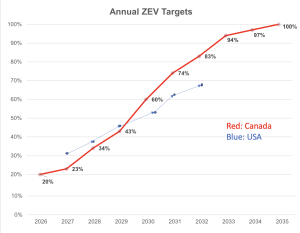EMC’s Canadian perspective and commentary following the publication of the EPA’s revised Tailpipe Emissions Standards
March 21, 2024
EMC finds that pressures for aligning with U.S. Standards are now moot, but regulatory footprint loopholes in Canada must be removed.EMC finds that pressures for aligning with U.S. Standards are now moot, but regulatory footprint loopholes in Canada must be removed.
Electric Mobility Canada (EMC) has reviewed the EPA’s revised Multi-Pollutant Emissions Standards for light- and medium-duty vehicle models starting from 2027 and declares that though the Standards have been weakened slightly for the first three years (2027-2030), they now align more closely with Canada’s EV Availability Standard. Automakers were using the stringency difference to argue against the EV Availability Standard’s targets. That argument is now irrelevant.

(ZEV targets: USA vs Canada)
EMC is concerned that the EPA’s standards remain footprint-based, leaving the regulation loopholes that incentivise car manufacturers to sell larger, heavier, and inefficient vehicles. The market will continue to favour large inefficient vehicles when climate change impacts should be motivating us towards smaller and/or more efficient cars, whether gas or electric. EMC recommends that Canada does not follow the U.S. on this path by removing and avoiding footprint-based loopholes in its emissions regulations.
On the bright side, EMC sees this announcement as the final stepping stone towards ensuring market predictability for the industry, consumers and governments. Considering the billions of dollars invested by the Canadian and U.S. governments and EV industry stakeholders from coast to coast who work in mining, battery, assembly, charging infrastructure, grid, sales, training, and maintenance, market predictability is key to ensuring their viable economic future.
